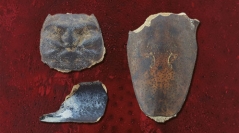

 Geodiversitas
47 (13) - Pages 577-622
Geodiversitas
47 (13) - Pages 577-622The extent to which the Cretaceous-Paleogene (K-Pg) extinction event impacted decapod crustaceans has yet to be tested rigorously due to a lack of studies at the outcrop scale. We comprehensively describe an early but not earliest Danian assemblage from Mussel Creek, central Alabama, United States, based on collecting of decapod carapaces and appendage remains at the roadcut part of this site since 2010. The specimens were recovered chiefly from silty, micaceous mudstones of the Pine Barren Member within the Clayton Formation, c. 8 m above the K-Pg boundary. Microfossil analysis indicates that the decapods originate from the lower middle part of the NP2 nannofossil zone, c. 600-700 ka after the K-Pg boundary. Based on 354 identifiable specimens, we recognize eight species: 1) four Brachyura: Alahexapus martini (Feldmann, Schweitzer & Portell, 2014) n. comb., Costacopluma nicksabani n. sp., Raninoides danicus n. sp., and an indeterminate representative of Palaeoxanthopsidae Schweitzer, 2003; 2) three Axiidea: Alphacheles zeta (Rathbun, 1936) n. comb., Ctenocheles sp., and Eucalliaxiopsis alabamensis (Rathbun, 1935a) n. comb.; and 3) one Paguroidea: “Paguristes” johnsoni Rathbun, 1935a. Two new genera are described: Alahexapus n. gen. and Alphacheles n. gen. The assemblage is dominated by specimens of C. nicksabani n. sp. (52% of identifiable specimens) and E. alabamensis n. comb. (31%). Three specimens of C. nicksabani n. sp. preserve rare gonopods. A rarefaction analysis indicates that (nearly) all species were collected. This assemblage represents the most diverse early Danian decapod assemblage from North America thus far, and provides a basis for further study of decapods across the K-Pg boundary.
Alabama, Anomura, Axiidea, Brachyura, Crustacea, Danian, Decapoda, Paleocene, new combinations, new genera, new species